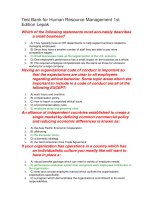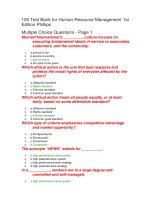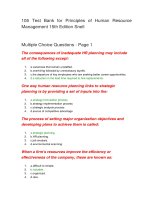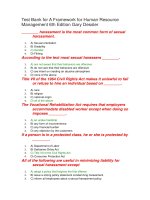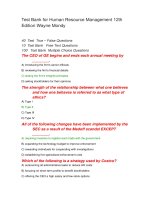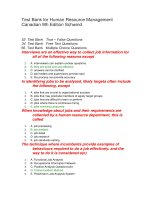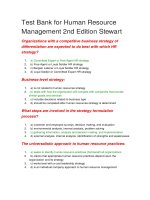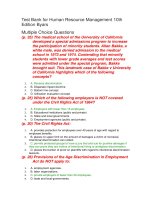Human resource management 14th edition mondy test bank
Bạn đang xem bản rút gọn của tài liệu. Xem và tải ngay bản đầy đủ của tài liệu tại đây (247.59 KB, 51 trang )
Human Resource Management, 14e (Mondy)
Chapter 2 Business Ethics and Corporate Social Responsibility
1) Which term refers to the discipline that deals with what is good and bad or right and wrong?
A) morals and traditions
B) social responsibility
C) cultural norms
D) ethics
Answer: D
Explanation: D) Ethics is the discipline dealing with what is good and bad, or right and wrong,
or with moral duty and obligation.
Difficulty: Easy
Skill: Concept
AACSB: Ethical understanding and reasoning
Learning Obj.: 1
2) Ethics, corporate social responsibility, and corporate sustainability are everyone's business,
including HR professionals.
Answer: TRUE
Explanation: Ethics, CSR, and corporate sustainability are everyone’s business. Human
resources (HR) professionals particularly concern themselves with establishing policies to
promote ethical behavior and unethical behavior. In addition, the human resource management
(HRM) function’s leadership works with other executive leadership to identify training
opportunities for educating employees about how they may make positive contributions to these
objectives and developing performance-based pay programs that align employee performance
with CSR and social responsibility goals.
Difficulty: Easy
Skill: Concept
AACSB: Ethical understanding and reasoning
Learning Obj.: 1
3) Citizenship is the discipline dealing with what is good and bad, or right and wrong, or with
moral duty and obligation.
Answer: FALSE
Explanation: Ethics is the discipline dealing with what is good and bad, or right and wrong, or
with moral duty and obligation.
Difficulty: Easy
Skill: Concept
AACSB: Ethical understanding and reasoning
Learning Obj.: 1
1
Copyright © 2016 Pearson Education, Inc.
4) What is the difference between ethics and corporate social responsibility as each concept
applies to corporations?
Answer: Ethics is the discipline dealing with what is good and bad, or right and wrong, or with
moral duty and obligation. Ethics is about deciding whether an action is good or bad and what to
do about it if it is bad. Those in management make ethical (or unethical) decisions every day
regarding hiring, safety, and compensation. Corporate social responsibility (CSR) is the implied,
enforced, or felt obligation of managers, acting in their official capacity, to serve or protect the
interests of groups other than themselves. When a corporation behaves as if it has a conscience, it
is said to be socially responsible. CSR considers the overall influence of corporations on society
at large and goes beyond the interests of shareholders. It is how a company as a whole behaves
toward society.
Difficulty: Challenging
Skill: Concept
AACSB: Ethical understanding and reasoning
Learning Obj.: 1
5) Which of the following firms has NOT been exposed for ethical abuses and corrupt conduct?
A) Enron
B) Lehman Brothers
C) WorldCom
D) General Electric (GE)
Answer: D
Explanation: D) Enron, Lehman Brothers, and WorldCom have been involved with ethical and
illegal problems. General Electric (GE) has a history of honesty and transparency.
Difficulty: Moderate
Skill: Concept
AACSB: Ethical understanding and reasoning
Learning Obj.: 2
6) In a recent survey, what percent of investors said they would move their account if they
discovered the company was involved in unethical behavior?
A) 17%
B) 37%
C) 67%
D) 97%
Answer: C
Explanation: C) CEOs have to be clear that unethical behavior is not acceptable. In one survey,
67 percent of investors said they would move their account if they discovered the company was
involved in unethical behavior.
Difficulty: Moderate
Skill: Concept
AACSB: Ethical understanding and reasoning
Learning Obj.: 2
2
Copyright © 2016 Pearson Education, Inc.
7) The CEO of GE begins and ends each annual meeting by ________.
A) introducing the firm's senior officials
B) reviewing the firm's financial details
C) stating the firm's integrity principles
D) asking stockholders for their opinions
Answer: C
Explanation: C) Jeff Immelt, GE's CEO, begins and ends each annual meeting of 220 officers
and of its 600 senior managers by restating the company's fundamental integrity principles:
"GE's business success is built on our reputation with all stakeholders for lawful and ethical
behavior. Commercial considerations never justify cutting corners. Upholding this standard is the
specific responsibility of the leaders in the room."
Difficulty: Challenging
Skill: Concept
AACSB: Ethical understanding and reasoning
Learning Obj.: 2
8) What do most of the 500 largest corporations in the United States have?
A) social responsibility audits
B) environmental audits
C) codes of ethics
D) podcasts
Answer: C
Explanation: C) Most of the 500 largest corporations in the United States now have a code of
ethics, which encompasses written conduct standards, internal education, and formal agreements
on industry standards, ethics offices, social accounting, and social projects.
Difficulty: Easy
Skill: Concept
AACSB: Ethical understanding and reasoning
Learning Obj.: 2
9) With regards to ethics, most of the 500 largest corporations in the U.S. now have a code of
ethics. Which of the following would LEAST likely be included in the codes?
A) ethics offices
B) social accounting
C) conduct standards
D) performance appraisals
Answer: D
Explanation: D) Most of the 500 largest corporations in the United States now have a code of
ethics, which encompasses written conduct standards, internal education, and formal agreements
on industry standards, ethics offices, social accounting, and social projects.
Difficulty: Moderate
Skill: Concept
AACSB: Ethical understanding and reasoning
Learning Obj.: 2
3
Copyright © 2016 Pearson Education, Inc.
10) The minimum standards of ethical behavior in a firm are based on ________, while higher
standards are established by ________.
A) corporate policies; human resources
B) co-workers; mission statements
C) organizational culture; laws
D) laws; corporate leadership
Answer: D
Explanation: D) Compliance with the law sets the minimum standard of ethical behavior; ethics
is much more, however. There must be leaders who are able and willing to instill ethics
throughout the culture of the organization because laws are only the beginning of the solution.
Difficulty: Challenging
Skill: Concept
AACSB: Ethical understanding and reasoning
Learning Obj.: 2
11) Surveys indicate that 25% of investors would move their account if they discovered the
company was involved in unethical behavior.
Answer: FALSE
Explanation: In one survey, 67 percent of investors said they would move their account if they
discovered the company was involved in unethical behavior.
Difficulty: Easy
Skill: Concept
AACSB: Ethical understanding and reasoning
Learning Obj.: 2
12) Most of the 500 largest corporations in the U.S. now have a code of ethics.
Answer: TRUE
Explanation: Most of the 500 largest corporations in the United States now have a code of
ethics, which encompasses written conduct standards, internal education, and formal agreements
on industry standards, ethics offices, social accounting, and social projects.
Difficulty: Moderate
Skill: Concept
AACSB: Ethical understanding and reasoning
Learning Obj.: 2
13) Unethical practices are limited to Wall Street because of the money and pressure involved.
Answer: FALSE
Explanation: Business ethics scandals continue to be headline news today. Lying on résumés,
obstruction of justice, destruction of records, stock price manipulation, and cutting corners to
meet Wall Street's expectation. However, business is not alone. There is virtually no occupation
that has not had its own painful ethical crises in recent years.
Difficulty: Moderate
Skill: Concept
AACSB: Ethical understanding and reasoning
Learning Obj.: 2
4
Copyright © 2016 Pearson Education, Inc.
14) Compliance with the law sets the minimum standard for ethical behavior in business.
Answer: TRUE
Explanation: Compliance with the law sets the minimum standard for ethical behavior; ethics,
however, is much more. There must be leaders who are able and willing to instill ethics
throughout the culture of the organization.
Difficulty: Moderate
Skill: Concept
AACSB: Ethical understanding and reasoning
Learning Obj.: 2
15) A major source of ethical guidance is the behavior and advice of people that psychologists
call ________.
A) internal monitors
B) third-party respondents
C) disinterested parties
D) significant others
Answer: D
Explanation: D) Another source of ethical guidance is the behavior and advice of the people
psychologists call "significant others"-our parents, friends, role models, and members of our
churches, clubs, and associations.
Difficulty: Challenging
Skill: Concept
AACSB: Ethical understanding and reasoning
Learning Obj.: 3
16) According to your textbook, sources of ethical guidance should ________.
A) lead to your beliefs or a conviction about what is right or wrong
B) have little effect on a person's pursuit of what is expedient
C) be nothing more than the subject matter of philosophical discussions
D) remain abstractions that don't pertain to day-to-day living in today's world
Answer: A
Explanation: A) The sources of ethical guidance should lead to your beliefs or a conviction
about what is right or wrong.
Difficulty: Moderate
Skill: Concept
AACSB: Ethical understanding and reasoning
Learning Obj.: 3
5
Copyright © 2016 Pearson Education, Inc.
17) Laws ________ ethical behavior.
A) mandate
B) offer guidance to
C) have nothing to do with
D) None of the above
Answer: B
Explanation: B) Laws offer guidance to ethical behavior, prohibiting acts that can be especially
harmful to others.
Difficulty: Moderate
Skill: Concept
AACSB: Ethical understanding and reasoning
Learning Obj.: 3
18) Which of the following would LEAST likely be a source of ethical guidance?
A) holy books
B) laws
C) friends
D) tests
Answer: D
Explanation: D) One might use a number of sources to determine what is right or wrong, good
or bad, moral or immoral. These sources include the Bible and other holy books. Another source
of ethical guidance is the behavior and advice of our parents, friends, and role models. Laws also
offer guidance to ethical behavior, prohibiting acts that can be especially harmful to others.
Difficulty: Moderate
Skill: Concept
AACSB: Ethical understanding and reasoning
Learning Obj.: 3
19) As a professional, what should be your primary source of ethical guidance in the workplace?
A) corporate HR policies
B) corporate code of ethics
C) corporate mission statement
D) corporate procedures
Answer: A
Explanation: A) For most professionals, there are written codes of ethics that prescribe certain
behavior. Without this written code of ethical conscience, it might be easy to say, "Everyone
does it," "Just this once won't hurt," or "No one will ever know."
Difficulty: Moderate
Skill: Application of knowledge
AACSB: Ethical understanding and reasoning
Learning Obj.: 3
6
Copyright © 2016 Pearson Education, Inc.
20) Sources of ethical guidance exclude laws because laws are mandated by the government and
not personal beliefs and values.
Answer: FALSE
Explanation: Laws also offer guidance to ethical behavior, prohibiting acts that can be especially
harmful to others. They codify what society has deemed to be unacceptable. If a certain behavior
is illegal, most would consider it to be unethical as well. There are exceptions, of course. For
example, through the 1950s, laws in most southern states relegated blacks to the backs of buses
and otherwise assigned them inferior status. Martin Luther King Jr. resisted such laws and, in
fact, engaged in civil disobedience and other nonviolent forms of resistance to their enforcement.
King won the Nobel Peace Prize for his efforts.
Difficulty: Moderate
Skill: Concept
AACSB: Ethical understanding and reasoning
Learning Obj.: 3
21) According to the model of ethics, advice from friends, holy books, and laws serve as sources
of ethical guidance.
Answer: TRUE
Explanation: People use a number of sources to determine what is right or wrong, good or bad,
moral or immoral. These sources include the Bible and other holy books, the inner conscience,
friends, family members, and laws.
Difficulty: Easy
Skill: Concept
AACSB: Ethical understanding and reasoning
Learning Obj.: 3
22) According to psychologists, the behavior and advice of "significant others" is a source of
ethical guidance.
Answer: TRUE
Explanation: A major source of ethical guidance is the behavior and advice of the people
psychologists call "significant others"-our parents, friends, and role models and members of our
churches, clubs, and associations.
Difficulty: Challenging
Skill: Concept
AACSB: Ethical understanding and reasoning
Learning Obj.: 3
23) Laws offer guidance to ethical behavior, prohibiting acts that can be especially harmful to
others.
Answer: TRUE
Explanation: Laws also offer guidance to ethical behavior, prohibiting acts that can be especially
harmful to others. They codify what society has deemed to be unacceptable. If a certain behavior
is illegal, most would consider it to be unethical as well.
Difficulty: Easy
Skill: Concept
AACSB: Ethical understanding and reasoning
Learning Obj.: 3
7
Copyright © 2016 Pearson Education, Inc.
24) In the legal use of the term, a whistleblower is someone who ________.
A) serves as a part-time referee in sporting events
B) has an ethical obligation to shield his or her employer from lawsuits
C) participates in an activity that is protected by federal law
D) serves as a majordomo at political dinners
Answer: C
Explanation: C) In the legal use of the term, a whistleblower is someone who is protected by the
following federal laws: the False Claims Act, the Internal Revenue Service's Informant Claims
Program, The Dodd-Frank Wall Street Reform and Consumer Protection Act, and the SarbanesOxley Act of 2002.
Difficulty: Moderate
Skill: Concept
AACSB: Ethical understanding and reasoning
Learning Obj.: 4
25) When comparing the effectiveness of whistleblowers and external auditors in uncovering
corporate wrongdoings, ________ in public companies.
A) whistleblower tips discovered 54.1 percent of uncovered fraud schemes
B) external auditors discovered 54.1 percent of uncovered fraud schemes
C) whistleblower tips discovered 4.1 percent of uncovered fraud schemes
D) whistleblower tips are no more effective than external auditors at discovering fraud schemes
Answer: A
Explanation: A) Many believe that information provided by whistleblowers is much more
effective in uncovering wrongdoings than are external auditors. In testimony to the Senate
Banking Committee, Certified Fraud Examiner Harry Markopolos stated, "Whistleblower tips
detected 54.1 percent of uncovered fraud schemes in public companies. External auditors
detected a mere 4.1 percent of fraud schemes."
Difficulty: Challenging
Skill: Concept
AACSB: Ethical understanding and reasoning
Learning Obj.: 4
26) Whistleblower protection has been around since ________.
A) the passage of the Sarbanes-Oxley Act of 2002
B) the Dodd-Frank Wall Street Reform and Consumer Protection Act of 2010
C) the Federal False Claims Act of 1863
D) the Whistleblowers Anonymity Act of 2005
Answer: C
Explanation: C) The use of whistleblowers has been around since 1863 when President Lincoln
signed into law the Federal False Claims Act, which was designed to protect the United States
from purchases of fake gunpowder during the Civil War.
Difficulty: Easy
Skill: Concept
AACSB: Ethical understanding and reasoning
Learning Obj.: 4
8
Copyright © 2016 Pearson Education, Inc.
27) Companies are concerned about the whistleblower part of the Dodd-Frank Act for all of the
following reasons except that informants might ________.
A) skip internal channels and go straight to government authorities
B) use the whistleblower provision to settle other grievances with their companies
C) overload internal compliance channels and thus hinder internal compliance efforts
D) All of the above
Answer: C
Explanation: C) Companies have some uneasiness regarding the whistleblower provision of the
Dodd-Frank Act. The major concern is that the rules run counter to a firm's internal compliance
efforts. Companies are afraid that employees will not go through internal channels first and
instead go directly to government authorities. Another fear is that an employee might have
another grievance with the company and use the whistleblower provision to get back at the
company.
Difficulty: Moderate
Skill: Concept
AACSB: Ethical understanding and reasoning
Learning Obj.: 4
28) All of the following EXCEPT ________ are major components of the Dodd-Frank Wall
Street Reform and Consumer Protection Act.
A) protecting investors
B) promoting too-big-to-fail bailouts
C) maintaining an advance warning system
D) enforcing regulations that are already on the books
Answer: B
Explanation: B) The Dodd-Frank Wall Street Reform and Consumer Protection Act ends the
possibility that taxpayers will be asked to bail out financial firms that threaten the economy.
Difficulty: Moderate
Skill: Concept
AACSB: Ethical understanding and reasoning
Learning Obj.: 4
29) The Dodd-Frank Wall Street Reform and Consumer Protection Act was signed into law in
________.
A) 1863
B) 1933
C) 2001
D) 2010
Answer: D
Explanation: D) The Dodd-Frank Wall Street Reform and Consumer Protection Act was signed
into law in 2010. The act was brought on by the worst financial crisis since the Great Depression.
Difficulty: Moderate
Skill: Concept
AACSB: Ethical understanding and reasoning
Learning Obj.: 4
9
Copyright © 2016 Pearson Education, Inc.
30) Which of the following laws was NOT enacted for the purpose of legislating business ethics?
A) Federal Sentencing Guidelines for Organizations Act
B) Procurement Integrity Act
C) Sarbanes-Oxley Act
D) Taft-Hartley Act
Answer: D
Explanation: D) The Taft-Hartley Act was enacted to monitor the power and activities of unions.
The other three laws were three attempts made by the government to legislate business ethics.
Difficulty: Moderate
Skill: Concept
AACSB: Ethical understanding and reasoning
Learning Obj.: 4
31) What law prohibits the release of source selection and proposal information?
A) Federal Sentencing Guidelines for Organizations
B) Procurement Integrity Act
C) Sarbanes-Oxley Act
D) Federal Contract Protection Act
Answer: B
Explanation: B) The Procurement Integrity Act of 1988 prohibits the release of source selection
and contractor bid or proposal information. Also, a former employee who served in certain
positions on a procurement action or contract in excess of $10 million is barred from receiving
compensation as an employee or consultant from that contractor for one year.
Difficulty: Moderate
Skill: Concept
AACSB: Analytical thinking
Learning Obj.: 4
32) Which law prohibits a former employee who served in certain positions on a contract in
excess of $10 million from receiving compensation as an employee or consultant from that
contractor for one year?
A) Federal Sentencing Guidelines for Organizations
B) Procurement Integrity Act
C) Sarbanes-Oxley Act
D) Federal Contract Protection Act
Answer: B
Explanation: B) The Procurement Integrity Act of 1988 prohibits the release of source selection
and contractor bid or proposal information. Also, a former employee who served in certain
positions on a procurement action or contract in excess of $10 million is barred from receiving
compensation as an employee or consultant from that contractor for one year.
Difficulty: Moderate
Skill: Concept
AACSB: Ethical understanding and reasoning
Learning Obj.: 4
10
Copyright © 2016 Pearson Education, Inc.
33) What law was passed in response to reports of military contracts for $500 toilet seats?
A) Federal Sentencing Guidelines for Organizations
B) Sarbanes-Oxley Act
C) Federal Contract Protection Act
D) Procurement Integrity Act
Answer: D
Explanation: D) The Procurement Integrity Act of 1988 prohibits the release of source selection
and contractor bid or proposal information. The Act was passed after there were reports of
military contracts for $500 toilet seats.
Difficulty: Moderate
Skill: Concept
AACSB: Ethical understanding and reasoning
Learning Obj.: 4
34) What federal law offers easier punishments for wayward corporations that have ethics
programs in place?
A) Federal Sentencing Guidelines for Organizations
B) Procurement Integrity Act
C) Sarbanes-Oxley Act
D) Federal Contract Protection Act
Answer: A
Explanation: A) The 1992 Federal Sentencing Guidelines for Organizations Act (FSGO)
outlined an effective ethics training program and explained the seven minimum requirements for
an effective program to prevent and detect violations. The FSGO promised softer punishments
for wayward corporations that already had ethics programs in place.
Difficulty: Moderate
Skill: Concept
AACSB: Ethical understanding and reasoning
Learning Obj.: 4
35) What federal law outlined an effective ethics training program and explained the seven
minimum requirements for an effective program to prevent and detect violations?
A) Federal Sentencing Guidelines for Organizations
B) Procurement Integrity Act
C) Sarbanes-Oxley Act
D) Federal Contract Protection Act
Answer: A
Explanation: A) The 1992 Federal Sentencing Guidelines for Organizations Act (FSGO)
outlined an effective ethics training program and explained the seven minimum requirements for
an effective program to prevent and detect violations. The FSGO promised softer punishments
for wayward corporations that already had ethics programs in place.
Difficulty: Moderate
Skill: Concept
AACSB: Ethical understanding and reasoning
Learning Obj.: 4
11
Copyright © 2016 Pearson Education, Inc.
36) Which of the following was NOT included in the FSGO?
A) guidelines for ethics standards
B) job security for whistleblowers
C) guidelines for providing ethics training
D) system for anonymously reporting misconduct
Answer: B
Explanation: B) The FSGO promised softer punishments for wayward corporations that already
had ethics programs in place. In the law were recommendations regarding standards, ethics
training, and a system to report misconduct anonymously. The Sarbanes-Oxley Act provided
protections for whistleblowers.
Difficulty: Challenging
Skill: Concept
AACSB: Ethical understanding and reasoning
Learning Obj.: 4
37) According to the FSGO, ________ were supposed to be responsible for the prevention of
white collar crimes in an organization.
A) attorneys
B) top executives
C) common stockholders
D) organizational stakeholders
Answer: B
Explanation: B) According to the FSGO, executives were supposed to be responsible for the
misconduct of those lower in the organization. If executives were proactive in their efforts to
prevent white collar crime it would lessen a judgment against them and reduce the liability.
Difficulty: Moderate
Skill: Concept
AACSB: Analytical thinking
Learning Obj.: 4
38) Which law most likely prompted organizations to create codes of ethics and install ethics
hotlines?
A) Corporate and Auditing Accountability, Responsibility, and Transparency Act
B) Federal Sentencing Guidelines for Organizations Act
C) Procurement Integrity Act
D) McCarran-Ferguson Act
Answer: B
Explanation: B) The McCarran-Ferguson Act relates insurance regulation rather than business
ethics. The FSGO led organizations to create ethics officer positions, install ethics hotlines, and
develop codes of ethics in hopes of lessening ethics judgments against the firm and reducing the
firm's liability.
Difficulty: Moderate
Skill: Concept
AACSB: Ethical understanding and reasoning
Learning Obj.: 4
12
Copyright © 2016 Pearson Education, Inc.
39) Which law criminalizes many corporate acts that were previously relegated to various
regulatory structures?
A) Federal Sentencing Guidelines for Organizations
B) Procurement Integrity Act
C) Sarbanes-Oxley Act
D) Federal Contract Protection Act
Answer: C
Explanation: C) The Corporate and Auditing Accountability, Responsibility, and Transparency
Act of 2002 criminalized many corporate acts that were previously relegated to various
regulatory structures. Known as the Sarbanes-Oxley Act, its primary focus is to redress
accounting and financial reporting abuses in light of corporate scandals.
Difficulty: Moderate
Skill: Concept
AACSB: Ethical understanding and reasoning
Learning Obj.: 4
40) Which law was passed to redress accounting and financial reporting abuses in light of
corporate scandals?
A) Federal Sentencing Guidelines for Organizations
B) Procurement Integrity Act
C) Sarbanes-Oxley Act
D) Federal Contract Protection Act
Answer: C
Explanation: C) The Corporate and Auditing Accountability, Responsibility, and Transparency
Act of 2002 criminalized many corporate acts that were previously relegated to various
regulatory structures. Known as the Sarbanes-Oxley Act, its primary focus is to redress
accounting and financial reporting abuses in light of corporate scandals.
Difficulty: Moderate
Skill: Concept
AACSB: Ethical understanding and reasoning
Learning Obj.: 4
41) Which law contains broad employee whistle-blower protections against firms and managers
that retaliate or harass employees who report suspected corporate wrongdoing?
A) Sarbanes-Oxley Act
B) Procurement Integrity Act
C) Federal Sentencing Guidelines for Organizations
D) Federal Contract Protection Act
Answer: A
Explanation: A) The Sarbanes-Oxley Act contains broad employee whistle-blower protections
that subject corporations and their managerial personnel to significant civil and criminal
penalties for retaliating, harassing, or discriminating against employees who report suspected
corporate wrongdoing.
Difficulty: Moderate
Skill: Concept
AACSB: Ethical understanding and reasoning
Learning Obj.: 4
13
Copyright © 2016 Pearson Education, Inc.
42) Erica, an accountant, notices suspicious accounting practices at the firm where she is
employed. She wants to report the unethical behavior to authorities but is worried that she might
be harassed or demoted as a result. Which law was passed to protect Erica in this situation?
A) Federal Contract Protection Act
B) Procurement Integrity Act
C) Taft-Hartley Act
D) Sarbanes-Oxley Act
Answer: D
Explanation: D) The Sarbanes-Oxley Act contains broad employee whistle-blower protections
that subject corporations and their managerial personnel to significant civil and criminal
penalties for retaliating, harassing, or discriminating against employees who report suspected
corporate wrongdoing.
Difficulty: Moderate
Skill: Application of knowledge
AACSB: Ethical understanding and reasoning
Learning Obj.: 4
43) John provides information to the SEC about conduct by his employer that he believes
constitutes securities fraud. Which law most likely protects John from being demoted for his
actions?
A) Federal Contract Protection Act
B) Procurement Integrity Act
C) Sarbanes-Oxley Act
D) Taft-Hartley Act
Answer: C
Explanation: C) The Sarbanes-Oxley Act states that management may not discharge, demote,
suspend, threaten, harass, or in any other manner discriminate against an employee protected by
the Act. It protects any employee who lawfully provides information to governmental authorities
concerning conduct he or she reasonably believes constitutes mail, wire, or securities fraud;
violations of any rule or regulation issued by the SEC; or violations of any other federal law
relating to fraud against shareholders.
Difficulty: Moderate
Skill: Concept
AACSB: Ethical understanding and reasoning
Learning Obj.: 4
14
Copyright © 2016 Pearson Education, Inc.
44) Which 2003 Supreme Court case upheld Sarbanes-Oxley's whistleblower-protection rule?
A) Dothard v Rawlingson
B) Bechtel v Competitive Technologies Inc.
C) O'Connor v Consolidated Coin Caterers Corp.
D) Grutter v Bollinger
Answer: B
Explanation: B) In the 2003 Bechtel v Competitive Technologies Inc. Supreme Court case
involving wrongful termination under Sarbanes-Oxley's whistle-blower-protection rule, the
Court ruled that the company violated the Act by firing two employees and ordered them
reinstated. They were fired because during a meeting they had raised concerns about the
company's decision not to report, on its SEC filing, an act they thought should have been
disclosed.
Difficulty: Moderate
Skill: Concept
AACSB: Ethical understanding and reasoning
Learning Obj.: 4
45) The Supreme Court ruling in Bechtel v Competitive Technologies Inc. upheld which federal
law?
A) McCarran-Ferguson Act
B) Sarbanes-Oxley Act
C) Davis-Bacon Act
D) Taft-Hartley Act
Answer: B
Explanation: B) In the 2003 Bechtel v Competitive Technologies Inc. Supreme Court case
involving wrongful termination under Sarbanes-Oxley's whistle-blower-protection rule, the
Court ruled that the company violated the Act by firing two employees and ordered them
reinstated. They were fired because during a meeting they had raised concerns about the
company's decision not to report, on its SEC filing, an act they thought should have been
disclosed.
Difficulty: Easy
Skill: Concept
AACSB: Ethical understanding and reasoning
Learning Obj.: 4
15
Copyright © 2016 Pearson Education, Inc.
46) According to the Sarbanes-Oxley Act, any SEC reporting bank that does not have a code of
ethics must ________.
A) submit a report to Congress
B) provide an explanation
C) pay a significant fine
D) develop an ethics code
Answer: B
Explanation: B) Sarbanes-Oxley requires publicly traded companies to disclose whether or not
they have adopted a code of ethics for senior officers. The Act does not require SEC reporting
banks and bank-holding companies to have a code of ethics, but if an SEC reporting company
does not have one, it must explain why.
Difficulty: Moderate
Skill: Concept
AACSB: Ethical understanding and reasoning
Learning Obj.: 4
47) Which of the following is NOT required by the Sarbanes-Oxley Act?
A) Publicly traded firms must disclose whether they have a code of ethics for top executives.
B) Publicly traded firms must not discharge employees who report ethical abuses.
C) Bank-holding companies and SEC reporting banks must have codes of ethics.
D) Corporations must not provide financial loans to executives or directors.
Answer: C
Explanation: C) The Sarbanes-Oxley Act does not require SEC reporting banks and bankholding companies to have a code of ethics. It requires publicly traded companies to disclose
whether or not they have adopted a code of ethics for senior officers. The Act states that
management may not discharge, demote, suspend, threaten, harass, or in any other manner
discriminate against an employee protected by the Act. The law prohibits loans to executives and
directors.
Difficulty: Challenging
Skill: Concept
AACSB: Ethical understanding and reasoning
Learning Obj.: 4
48) The primary purpose of an ethics audit is to ________.
A) ensure that EEO policies are being implemented
B) supplement a company's code of ethics
C) evaluate a company's ethical culture
D) interview ethics training candidates
Answer: C
Explanation: C) An ethics audit is simply a systematic, independent, and documented process
for obtaining evidence regarding the status of an organization's ethical culture. It is taking a
closer look at a firm's ethical culture instead of just allowing it to remain unexamined.
Difficulty: Moderate
Skill: Concept
AACSB: Ethical understanding and reasoning
Learning Obj.: 4
16
Copyright © 2016 Pearson Education, Inc.
49) Harvey Electronics has used a number of methods to create an ethical culture that both
employees and customers appreciate. What is the most effective way for the firm to sustain its
ethical culture?
A) asking job candidates ethical questions
B) implementing an ethics audit regularly
C) publishing the firm's code of ethics periodically
D) ensuring that new employees receive ethics training
Answer: B
Explanation: B) One way to create and sustain an ethical culture is to audit your ethics, much as
you might audit your finances each year. An ethics audit is simply a systematic, independent, and
documented process for obtaining evidence regarding the status of an organization's ethical
culture. It is taking a closer look at a firm's ethical culture instead of just allowing it to remain
unexamined.
Difficulty: Challenging
Skill: Application of knowledge
AACSB: Ethical understanding and reasoning
Learning Obj.: 4
50) According to the Malcolm Baldrige National Quality Award, senior leaders should
________.
A) serve as figureheads
B) serve as role models
C) delegate responsibility for ethical behavior to middle managers
D) operate outside of ethical constraints that apply to rank and file employees
Answer: B
Explanation: B) According to criteria for the Malcolm Baldrige National Quality Award, senior
leaders should serve as role models for the rest of their organizations. Baldrige applicants are
asked questions about how senior leaders create an environment that fosters legal and ethical
behavior. They need to show how the leaders address governance matters such as fiscal
accountability and independence in audits.
Difficulty: Easy
Skill: Concept
AACSB: Ethical understanding and reasoning
Learning Obj.: 4
17
Copyright © 2016 Pearson Education, Inc.
51) A recent survey of 358 compliance and ethical professionals revealed that ________.
A) nearly seventy-five percent of companies include ethical compliance as a basis of
compensation
B) twenty-seven percent of companies penalize employees for practicing ethical behavior
C) about one company in six ties employee bonuses and incentives to ethical performance
D) None of the above
Answer: C
Explanation: C) A survey of 358 compliance and ethics professionals by the Society of
Corporate Compliance and Ethics (SCCE) and Health Care Compliance Association found that
only a few companies have made ethics and compliance a process for determining how
employees are compensated, and only about one company in six ties employee bonuses and
incentives to ethical performance.
Difficulty: Moderate
Skill: Concept
AACSB: Ethical understanding and reasoning
Learning Obj.: 4
52) The garment factory building collapse in Bangladesh in 2013 in which 1,127 people lost their
lives, is simply an example of poor engineering.
Answer: FALSE
Explanation: Although some companies continue to say that they are fully committed to CSR,
their less-than-socially-responsible behavior does not support their stated commitment. The
garment factory building collapse in Bangladesh in 2013 stands among history's worst industrial
disasters, officially claiming 1,127 lives.
Difficulty: Easy
Skill: Concept
AACSB: Ethical understanding and reasoning
Learning Obj.: 4
53) The Dodd-Frank Wall Street Reform and Consumer Protection Act was signed into law in
2010.
Answer: TRUE
Explanation: The Dodd-Frank Wall Street Reform and Consumer Protection Act was enacted in
2010, in response to the greatest financial crisis since the Great Depression.
Difficulty: Challenging
Skill: Concept
AACSB: Ethical understanding and reasoning
Learning Obj.: 4
18
Copyright © 2016 Pearson Education, Inc.
54) The Procurement Integrity Act of 1988 was passed after reports of military contracts for
$500 toilet seats and $5,000 hammers.
Answer: TRUE
Explanation: The Procurement Integrity Act of 1988, prohibits the release of source selection
and contractor bid or proposal information. The Act was passed after there were reports of
military contracts for $500 toilet seats and $5,000 hammers.
Difficulty: Moderate
Skill: Concept
AACSB: Ethical understanding and reasoning
Learning Obj.: 4
55) According to the Procurement Integrity Act, if a firm that has an ethics program in place is
found guilty of misconduct, the firm will receive a reduced punishment.
Answer: FALSE
Explanation: The Federal Sentencing Guidelines for Organizations Act promised softer
punishments for wayward corporations that already had ethics programs in place. The
Procurement Integrity Act of 1988, prohibits the release of source selection and contractor bid or
proposal information.
Difficulty: Moderate
Skill: Concept
AACSB: Ethical understanding and reasoning
Learning Obj.: 4
56) Although laws cannot mandate ethics, they may be able to identify the baseline separating
what is good and what is bad.
Answer: TRUE
Explanation: Many experts contend that ethics cannot be legislated. Although laws cannot
mandate ethics, they may be able to identify the baseline separating what is good and what is
bad.
Difficulty: Easy
Skill: Concept
AACSB: Ethical understanding and reasoning
Learning Obj.: 4
57) The Corporate and Auditing Accountability, Responsibility and Transparency Act is also
known as the Sarbanes-Oxley Act.
Answer: TRUE
Explanation: The Corporate and Auditing Accountability, Responsibility, and Transparency Act
of 2002 was passed to legislate business ethics. The act, also known as the Sarbanes-Oxley Act,
criminalized many corporate acts that were previously relegated to various regulatory structures.
Difficulty: Moderate
Skill: Concept
AACSB: Ethical understanding and reasoning
Learning Obj.: 4
19
Copyright © 2016 Pearson Education, Inc.
58) The Federal Sentencing Guidelines for Organizations Act contains broad employee whistleblower protections that subject corporations to penalties for retaliating against employees who
report suspected corporate wrongdoing.
Answer: FALSE
Explanation: The Sarbanes-Oxley Act contains broad employee whistle-blower protections that
subject corporations and their managerial personnel to significant civil and criminal penalties for
retaliating, harassing, or discriminating against employees who report suspected corporate
wrongdoing.
Difficulty: Easy
Skill: Concept
AACSB: Ethical understanding and reasoning
Learning Obj.: 4
59) The Sarbanes-Oxley Act was passed in response to reports of out-of-control military
spending.
Answer: FALSE
Explanation: The Sarbanes-Oxley Act was passed to redress accounting and financial reporting
abuses in light of corporate scandals rather than military spending.
Difficulty: Easy
Skill: Concept
AACSB: Ethical understanding and reasoning
Learning Obj.: 4
60) In the 2003 case Bechtel v Competitive Technologies Inc., the Supreme Court overturned
Sarbanes-Oxley's whistleblower-protection rule.
Answer: FALSE
Explanation: Bechtel v Competitive Technologies Inc. involved wrongful termination under
Sarbanes-Oxley's whistleblower protection rule. The Court ruled that the company violated the
Act by firing two employees and ordered them reinstated, so the whistleblower protection rule
was upheld.
Difficulty: Moderate
Skill: Concept
AACSB: Ethical understanding and reasoning
Learning Obj.: 4
61) The Corporate and Auditing Accountability, Responsibility and Transparency Act requires
SEC reporting banks and bank holding companies to have a code of ethics.
Answer: FALSE
Explanation: The Corporate and Auditing Accountability, Responsibility and Transparency Act
does not require SEC reporting banks and bank holding companies to have a code of ethics, but
if an SEC reporting company does not have one, it must explain why.
Difficulty: Moderate
Skill: Concept
AACSB: Ethical understanding and reasoning
Learning Obj.: 4
20
Copyright © 2016 Pearson Education, Inc.
62) Identify and discuss the federal government's four attempts to legislate business ethics since
the late 1980s.
Answer: The Procurement Integrity Act of 1988 prohibited the release of source selection and
contractor bid or proposal information. In addition, a former employee who served in certain
positions on a procurement action or contract in excess of $10 million cannot receive
compensation as an employee or consultant from that contractor for one year. The second
attempt occurred with the passage of the 1992 Federal Sentencing Guidelines for Organizations
Act (FSGO), which outlined an effective ethics training program and explained the seven
minimum requirements for an effective program to prevent and detect violations. The third
attempt at legislating business ethics was the Corporate and Auditing Accountability,
Responsibility, and Transparency Act of 2002 (Sarbanes-Oxley Act), which criminalized many
corporate acts that were previously relegated to various regulatory structures. The primary focus
of the Sarbanes-Oxley Act is to redress accounting and financial reporting abuses in light of
corporate scandals. The fourth, the Dodd-Frank Wall Street Reform and Consumer Protection
Act, was signed into law in 2010. The act was brought on by the worst financial crisis since the
Great Depression, which resulted in the loss of 8 million jobs, failed businesses, a drop in
housing prices, and wiped out personal savings of many workers. As the financial crisis
advanced, it became clear that executive compensation played a major role in the financial
services sector as well as in the capital markets following the collapse of investment services
firms as Lehman Brothers, Merrill Lynch, Bear Stearns, and AIG.
Difficulty: Moderate
Skill: Concept
AACSB: Ethical understanding and reasoning
Learning Obj.: 4
63) Contemporary organizations are redesigning their ethics programs to facilitate a broader,
more consistent process that ________.
A) embraces chaos and forges new paradigms
B) incorporates the analysis of outcomes and continual improvement
C) uses outcome analysis to focus on short-term goals
D) relies on expediency and situational management
Answer: B
Explanation: B) Contemporary organizations are redesigning their ethics programs to facilitate a
broader, more consistent process that incorporates the analysis of outcomes and continual
improvement.
Difficulty: Moderate
Skill: Concept
AACSB: Ethical understanding and reasoning
Learning Obj.: 5
21
Copyright © 2016 Pearson Education, Inc.
64) An ethical culture consists of all of the following factors EXCEPT ________.
A) ethical leadership
B) guerilla marketing
C) values
D) accountability
Answer: B
Explanation: B) An ethical culture is made up of factors such as ethical leadership,
accountability, and values.
Difficulty: Moderate
Skill: Concept
AACSB: Ethical understanding and reasoning
Learning Obj.: 5
65) Executives and managers at ABC Enterprises actively encourage a strong ethical culture at
the firm. Which of the following would be the most likely result of the firm's actions?
A) increased employee interest in development programs
B) frequent use of human resource information systems
C) changes in corporate communication methods
D) improvements in organizational performance
Answer: D
Explanation: D) By fostering a strong ethical culture, firms are better able to gain the confidence
and loyalty of their employees and other stakeholders, which can result in reduced financial,
legal, and reputation risks, as well as improvements in organizational performance.
Difficulty: Challenging
Skill: Application of knowledge
AACSB: Ethical understanding and reasoning
Learning Obj.: 5
66) Which term refers to a statement of the values adopted by the company, its employees and its
directors?
A) code of ethics
B) ethical policies
C) vision statement
D) code of conduct
Answer: A
Explanation: A) The code of ethics is a statement of the values adopted by the company, its
employees, and its directors, and sets the official tone of top management regarding expected
behavior. A code of conduct tells employees what the rules of conduct are. The code of ethics
helps employees know what to do when there is not a rule for something.
Difficulty: Easy
Skill: Concept
AACSB: Ethical understanding and reasoning
Learning Obj.: 5
22
Copyright © 2016 Pearson Education, Inc.
67) Julia works as a production supervisor, and she believes one of her subordinates is drinking
during his lunch break. Julia's employer does not have a specific rule regarding the subordinate's
behavior. Which of the following would most likely assist Julia with her problem in this
situation?
A) corporate code of ethics
B) corporate vision statement
C) corporate code of conduct
D) federal legislation
Answer: A
Explanation: A) A distinction needs to be made between a code of conduct and a code of ethics;
the former should tell employees what the rules of conduct are. The code of ethics helps
employees know what to do when there is not a rule for something.
Difficulty: Moderate
Skill: Application of knowledge
AACSB: Ethical understanding and reasoning
Learning Obj.: 5
68) Lincoln Enterprises recently fired two employees who were caught stealing tools from the
firm's warehouse. As a result, the CEO of Lincoln wants to strengthen the firm's ethical culture
and prevent future violations by redesigning the firm's ethics program. Which of the following
questions is LEAST relevant when developing Lincoln's new ethics program?
A) What behavior is expected of Lincoln employees?
B) What is the opinion of stakeholders regarding Lincoln's ethics?
C) How are ethical situations communicated and resolved at Lincoln?
D) What is the process for Lincoln establishing a corporate giving program?
Answer: D
Explanation: D) Corporate giving programs are types of CSR programs and are less relevant to
how the firm redesigns its ethics program. The firm should review the expected behavior of
employees, the thoughts of stakeholders, and the current procedures for handling ethical
problems.
Difficulty: Challenging
Skill: Concept
AACSB: Ethical understanding and reasoning
Learning Obj.: 5
23
Copyright © 2016 Pearson Education, Inc.
69) Which of the following is NOT a major provision in the SHRM code of ethics?
A) professional responsibility
B) cultural understanding
C) professional development
D) fairness and justice
Answer: B
Explanation: B) Major provisions in the SHRM code of ethics include professional
responsibility, professional development, ethical leadership, fairness and justice, conflicts of
interest, and use of information. Cultural understanding is not a provision in the SHRM code of
ethics.
Difficulty: Moderate
Skill: Concept
AACSB: Ethical understanding and reasoning
Learning Obj.: 5
70) Vision Technologies wants to gain the confidence of employees and customers by
developing a strong ethical culture. Which of the following methods would be the best way for
the firm's HR department to accomplish this goal?
A) placing the code of ethics on the firm's intranet
B) posting the code of ethics in the breakroom
C) providing ethics training to employees
D) having employees sign ethics contracts
Answer: C
Explanation: C) To build and sustain an ethical culture, organizations need a comprehensive
framework that encompasses communication of behavior expectations, training on ethics and
compliance issues, stakeholder input, resolution of reported matters, and analysis of the entire
ethics program. Posting a code of ethics online or in a breakroom is less likely to be effective.
Having employees sign ethics contracts is helpful but less effective than providing training.
Difficulty: Challenging
Skill: Concept
AACSB: Ethical understanding and reasoning
Learning Obj.: 5
71) A code of ethics establishes the ________ that the organization lives by.
A) policies
B) procedures
C) values
D) technologies
Answer: C
Explanation: C) The code of ethics is a statement of the values adopted by the company, its
employees, and its directors, and sets the official tone of top management regarding expected
behavior.
Difficulty: Easy
Skill: Concept
AACSB: Ethical understanding and reasoning
Learning Obj.: 5
24
Copyright © 2016 Pearson Education, Inc.
72) Riley Manufacturing recently developed a code of ethics. Which of the following topics is
most likely covered in the document?
A) business conduct
B) fair competition
C) HR issues
D) all of the above
Answer: D
Explanation: D) Topics typically covered in a code of ethics might be business conduct, fair
competition, and workplace and HR issues.
Difficulty: Moderate
Skill: Application of knowledge
AACSB: Ethical understanding and reasoning
Learning Obj.: 5
73) According to Walmart's code of ethics, Edward, an employee in the sales department, cannot
accept gifts from suppliers because such actions would be a ________.
A) conflict of interest
B) double standard
C) regulatory breach
D) discriminatory act
Answer: A
Explanation: A) Firms involving purchasing and sales typically establish in a code of ethics that
accepting gifts from suppliers constitutes a conflict of interest. At Walmart, it is considered
unethical to accept gifts from suppliers. Gifts are either destroyed or given to charity.
Difficulty: Moderate
Skill: Application of knowledge
AACSB: Ethical understanding and reasoning
Learning Obj.: 5
74) In order to maintain the importance of a code of ethics to employees, large firms frequently
________.
A) write a code of conduct
B) send a memo to all employees
C) appoint an ethics officer
D) put the ethical code on the intranet
Answer: C
Explanation: C) To keep the code on the front burner for employees, larger firms appoint an
ethics officer. The ethics officer is the point person in guiding everyone in the company toward
ethical actions. This individual should be a person who understands the work environment.
Difficulty: Moderate
Skill: Concept
AACSB: Ethical understanding and reasoning
Learning Obj.: 5
25
Copyright © 2016 Pearson Education, Inc.
